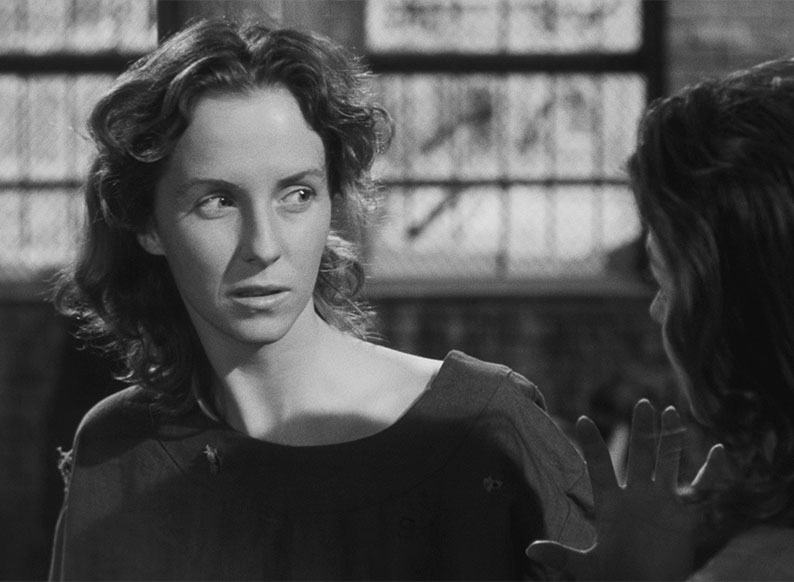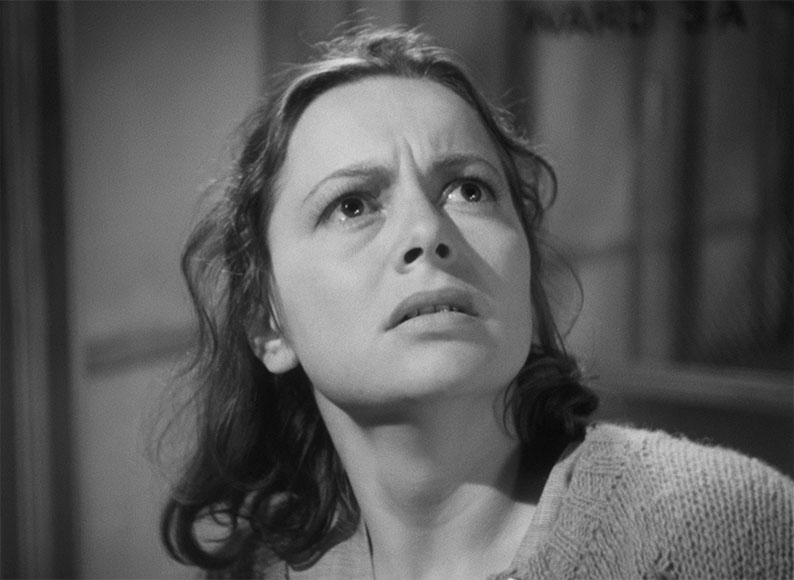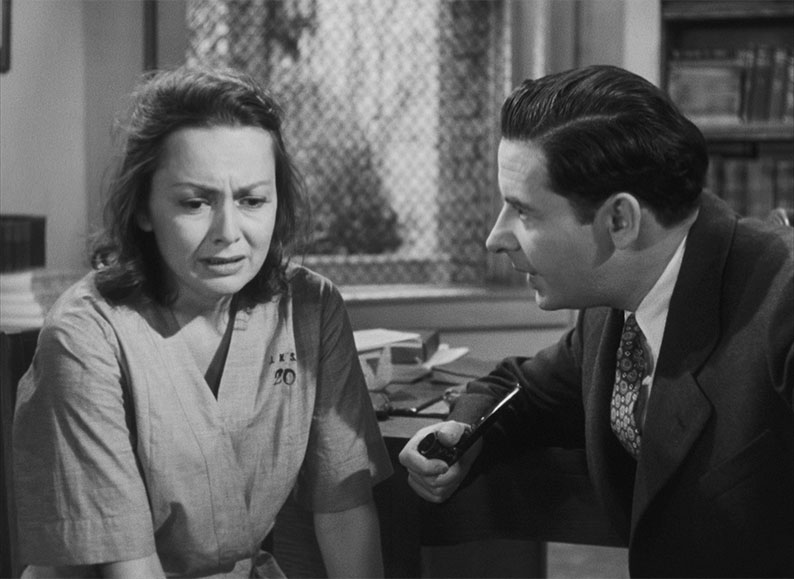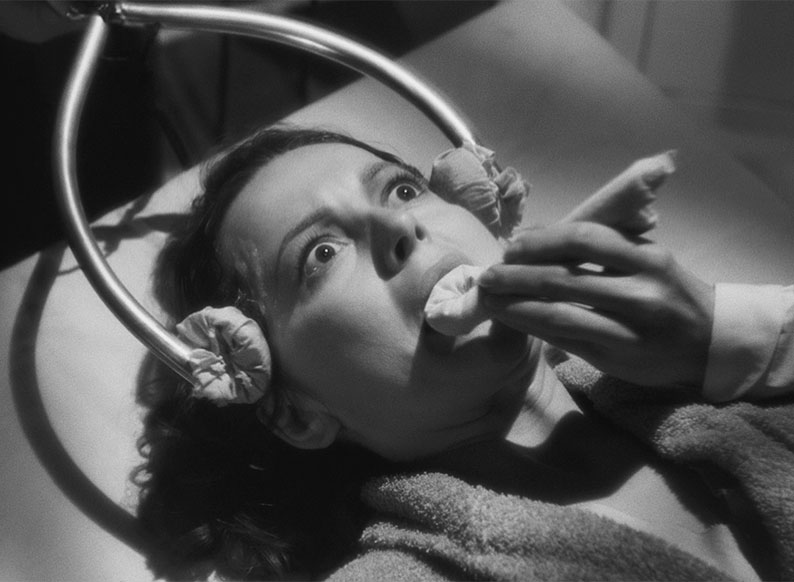| |
"When there's more sick ones than well ones, by golly the sick ones will lock the well ones up." |
| |
The Snake Pit author Mary Jane Ward |
I like to think we've come a long way in our societal response to mental health issues and how they should be treated. The simple fact that institutions that were once known as lunatic asylums or madhouses have been transformed into psychiatric hospitals should give an indication of progress we've made. We can certainly be thankful that society no longer believes that someone with serious mental health issues has been possessed by the Devil, but even today many respond to such conditions not with compassion but fear. Perhaps as a result, even today serious cinematic explorations of mental illness are rare, and were rarely even put forward for consideration during the early years of the medium. Madness in others would be featured in films primarily to terrorise or otherwise handicap a level-headed hero, and in science fiction cinema these same people were handed microscopes and given to having wild ambitions that could endanger the world. The afflicted were almost always antagonists, and the rest of the cast were usually too busy running and hiding from them to care a hoot about root cause of this their sociopathic behaviour.
It's a little too easy to assume that films that take mental illness seriously are a relatively modern phenomenon. Awards were showered on mainstream works like Rain Man and A Beautiful Mind, while One Flew Over the Cuckoo's Nest was only the second film in history to bag the Big Five Academy Awards (Film, Direction, Screenplay, Actor and Actress). Independent cinema, meanwhile, has given us works like Spider, Sling Blade and the heartbreaking Still Alice, to name but a few. This was not material for the commercially-minded Hollywood studios of the 1940s. Or was it? In 1945, psychogenic amnesia and psychoanalysis were both central to Alfred Hitchcock's Spellbound, and a year later the issue of posttraumatic stress disorder was confronted head on in William Wyler's The Best Years of Our Lives. Even so, I'd imagine that 1948 audiences were still given an eye-opening jolt when they sat down for Anatole Litvak's The Snake Pit, which as far as I'm aware was the first mainstream American film to be set primarily in what was then known as an insane asylum.

It is, of course, impossible to approach the film now as audiences did on its release. Too many films have come and gone since then, and almost anyone watching The Snake Pit for the first time today does so with an awareness of just why it is regarded as a landmark film. Yet it's still interesting to observe how it toys with a probably unprepared audience in the opening sequence, as young Virginia Stuart Cunningham – who is played by Olivia de Havilland, a major and instantly recognisable star of the period – sits on a bench in unflattering clothing and talks to a male figure we are unable to see and whom she then suspects has magically transformed into the woman sitting close to her. She quickly dismisses the idea as absurd and converses politely with the woman, whose name we later learn is Grace (Celeste Holm), but becomes frustrated when she cannot remember the address of her own apartment. Grace tells Virginia that she's been worried about her and then makes a cryptic comment about the number one and her possible departure, words that only make sense even to us on a second viewing. Then the call comes for them to assemble and Virginia is pulled anxiously into a line of women by the concerned Grace. As she notices that the windows are barred, Virginia initially thinks that they're visiting a zoo, though a short while later realises that something is more seriously amiss and becomes seriously agitated when she surmises that they are in a prison. It's then that she's approached by the kindly Dr. Kik (Leo Glenn) and a man she doesn't recognise but who claims to be her husband Robert (Mark Stevens). As she's led away, she seems comfortable with the idea that she's actually in prison to research a novel. She'll miss these people when she leaves, she reasons. By this point the audience should have put the pieces together and realised that Virginia is a patient in an asylum and that her condition is serious enough for her not to even be able recognise a doctor she sees every day. How she got there and the process of her treatment and possible recovery are the dual threads that drive the narrative of the film. The answers are slow in coming and are gradually revealed during the course of her treatment, sometimes in flashback, with Dr. Kik cast in the role of a psychiatric detective tasked with uncovering the cause of Virginia's unhappy state.
Despite the decades that have passed since the film's release, it's not hard to imagine the impact the film must have had in its day for the very simple reason that it still manages to pack a surprisingly hefty wallop. Some elements have certainly dated – just about everyone enjoys a smoke in this movie, and cigarette time is a popular patient privilege – and more than once it's hard to be sure on which side of the opinion fence the film is trying to sit. This is at its most blatant in the electroshock treatments that Virginia is subjected to, which are every bit as disturbing as the one administered to Jack Nicholson's R.P. McMurphy in One Flew Over the Cuckoo's Nest, a sequence that in some ways plays out in the same manner as the one here in which Virginia is led unknowingly in for her first treatment. Everything about how these treatments are shot, edited and scored (the music practically screams in pain as the shocks are administered) seems designed to prompt the audience to shudder with horror (I certainly did), yet later the clear suggestion is that they have had a beneficial effect. So after terrifying us with the process you're telling us now it's a good thing? I'm confused.

Yet writers Frank Partos and Millen Brand (from Mary Jane Ward's semi-autobiographical novel) and director Anatole Litvak still deliver a body-blow against institutions and practices that became the subject of real-world revision and reform after the film's release, notably when Virginia is transferred from a ward in which she has the very real potential to progress to one that has become a virtual dumping ground for the most seriously afflicted. Whether this maelstrom of madness is even close to the reality of life in an institution of the day is something I am in no position to confirm of deny, but it compellingly conveys the sense that Virginia has lost all control of her fate, as woman dance and rant around her in a variety of languages and ramble illogically at her from within their own enclosed reality bubbles. The action here is arrestingly choreographed to camera, as the film moves from one unfortunate soul to another, creating a suffocating montage of a world in which Virginia is trapped and that plays as an expressionistic reflection of her inner turmoil. It peaks as the camera moves upwards and dissolves into a process shot that literally places the almost insect-like patients in the snake pit of the title,* a shot so exquisitely doom-laden in its noir-like finality (complete as it is with an end-of-movie musical crescendo) that I was – for a few startled seconds – genuinely convinced that this is how the film was going to end.
Part of what makes the ever-shifting world to which Virginia is confined feel so authentic is Litvak's insistence that even the smallest roles by played by established actors, performers he then furnishes with interesting lines or bits of business to ensure that they register as individuals and not simply hover around anonymously in the background. This allows for a string of memorable encounters and exchanges with characters so intriguing and convincingly performed that they almost deserve a movie of their own. The most memorable of these is the silent and initially hostile young Hester, whom Virginia befriends and whose anxieties are vividly communicated through actor Betsy Blair's extraordinary expressions of locked-down fear, fierce distrust and barely supressed fury. It's in the small but still significant progress she makes, which is due entirely to Virginia's kindness and patient persistence, where hope for a more humanitarian way forward for the treatment of mental illness really lies.

And then there's Olivia de Havilland. If your image of de Havilland is as the smilingly love-struck Maid Marian in the The Adventures of Robin Hood or as Southern belle Melanie Hamilton in Gone with the Wind, then you've only been given a small taste of her considerable talent. Some of what makes her performance here so remarkable is almost to be expected – the role itself is a demanding one in which de Havilland is required to be alternately curious, confused, suspicious, frightened, angry, resentful and even calm and sweetly charming, all of which she launches into with stirring conviction. But as film historian Aubrey Solomon notes in his commentary track, where she really shows her metal is in the extraordinary way she is able to switch emotional responses or her alter her assessment of a situation in the blink of an eye and communicate this clearly to the audience through a changes in her facial expression and shifts in her body language. This is first really showcased in the opening scene, as Virginia joins the line of women being led back into the hospital and struggles to work out where she is and what is happening to her. In the course of her walk from the yard to the hospital interior, her expression shifts convincingly through worried confusion, cheerful comprehension, thoughtful concern, polite appreciation, troubled uncertainty, casual resignation, nervous apprehension, frightened realisation and fearful hostility, all in a mere two minutes of screen time and often in the space of a single shot. The nature of Virginia's condition means that this is far from an isolated example, and while there are sometimes also music cues and thoughts narration to clue us in to her sudden mood swings, it's primarily down to de Havilland's complete immersion in a role she apparently went to some trouble to research. I'm not being in any way hyperbolic when I say that this is easily the most arresting screen performance I've watched all year, and I'd argue that it's one of the finest you'll find in any classic era Hollywood movie – seriously, watch the film once for its drama and then watch it again with the hindsight of how the story plays out and focus your attention fully on de Havilland's performance. It's an absolute masterclass in subtly nuanced powerhouse screen acting.
The specifics of Dr. Kik's analysis do seem a little too by the Sigmund Freud for Beginners handbook (though were doubtless new territory for a good many audience members on the film's release), a hypothetical tome that was still providing clunky psychiatric explanations for mental illness 16 years later in the concluding scenes of Alfred Hitchcock's Psycho. The film also includes several of what would later become tropes of the prison movie, from the hard-nosed nurse/guard who makes life difficult for the central character to the inmate/prisoner who lands them in trouble out of personal spite. Some will doubtless feel that the late-film song that unites the prisoners overly sentimental, but a strong case is made for its effectiveness in the special features and I have no problem admitting that it brought a very real lump to my throat, and a moment involving Virginia and Hester that followed that some will regard as contrived brought an unexpected tear to my eye. It's a touching moment in a still-extraordinary example of classic era Hollywood social issue film entertainment at its best, a gripping, ground-breaking and superbly acted work whose most remarkable aspect, as Aubrey Solomon states on the commentary, was that it was made at all.
A clean and rigidly stable 1.37:1 1080p transfer with well-defined detail, a fine film grain and no evidence or artificial enhancement. The black levels are just (and I do mean only just) in the territory of deep grey, but this allows the picture detail to show through in the darker scenes, and the contrast range does feel right for the film's sometimes oppressive mood.

The Linear PCM 1.0 mono soundtrack is also free of damage and handles the dialogue, music and sound effects cleanly and clearly, albeit with the expected range restrictions. I'm still dealing with some head-splitting tinnitus and some partial frequency deafness, but even with the volume cranked up I couldn't hear any serious background hiss or fluff.
The expected optional English subtitles for the deaf and hearing impaired are present and correct.
Audio Commentary with Aubrey Solomon
A first-rate commentary track from the author of The Fox Film Corporation, 1915-1935: A History and Filmography and (as co-author) Films of Twentieth Century Fox that is crammed with interesting facts and opinion about the film. We get information on source novel author Mary Jane Ward, screenwriter Millen Brand, editor Dorothy Spencer, director Anatole Litvak, executive producer Darryl F. Zanuck, composer Alfred Newman, the larger-than-usual number of bit parts and significant supporting characters, some of the key differences between the book and the film, and a lot more. Some of the attention to even small detail is nicely highlighted (there's stuff picked up by Solomon that I might have otherwise missed), quotes from some of the more positive reviews are read and Solomon even provides details of a psychiatric disorder portrayed in the film. There are a few small gaps here, but when Solomon speaks he really delivers.
The Battles of Olivia de Havilland (9:26)
Critic and film historian Pamela Hutchinson looks back at the life and career Olivia de Havilland and reveals information about her that I was unaware of, notably in regard to a successful legal battle with Warner Brothers over actors' contracts that led to what became known as the De Havilland Law. She also looks at some of her key roles and highlights the specific qualities of the best of them.
Under Analysis(30:58)
Soft-spoken human film encyclopaedia Neil Sinyard is back to focus his perceptive attention on Olivia de Havilland, Anatole Litvak and The Snake Pit, which he greatly admires and describes up front as a milestone film. He nicely rebukes those contemporary (British) critics who claimed that the film was sensationalised by referencing Frances Farmer's autobiography, whose description of the abuse she was subjected to and treatment inflicted on her makes The Snake Pit "seem restrained by comparison." He notes the critical unanimity on the brilliance of Olivia de Havilland's performance, picks up on the film's conflicting viewpoint on electroshock treatment, and makes a nice observation and why the climactic song is so effective.

Theatrical Trailer (2:22)
“An announcement of startling importance to the world of entertainment” reads the caption that heads a trailer that makes great play of the regard in which the best-selling source novel is held, but boasts far fewer extracts of the film itself that I'd have expected, especially given the wealth of impressive material to draw on.
Image Gallery
30 crisply scanned slides of promotional imagery, including a sprinkling of posters.
Booklet
Another strong Indicator booklet begins with an excellent essay of the film, its making and the changes made to Mary Jane Ward's acclaimed source novel by Senior Lecturer in Film at the University of East London, Dr. Lindsay Hallam. Next up is an uncredited piece that adds to Dr. Hallam's coverage of the making of the film and includes quotes from, and references to, a number of magazine articles about the production. Extracts from several contemporary reviews have been reproduced, almost all of them positive, though the one by C.A. Lejeune in The Observer has its claws out for a film that the author opines had no reason for existence. Do me a favour. Credits for the film and promotional imagery have also been included.
For reasons I'm unable to justify, I've been fully aware of The Snake Pit and its reputation as a ground-breaking film since I first fell in love with cinema and started reading about the works that shaped its history, but somehow I never got around to seeing it until Indicator's Blu-ray landed on my doormat. It was, as they say, well worth the wait, for the noir-tinged manner in which its intriguing story unfolds, for the still-potent power of individual scenes, and most of all for Olivia de Havilland's extraordinary lead performance. As you would expect by now, the transfer is first-rate and the special features really compliment the film. Once again, this gets our highest recommendation.
|